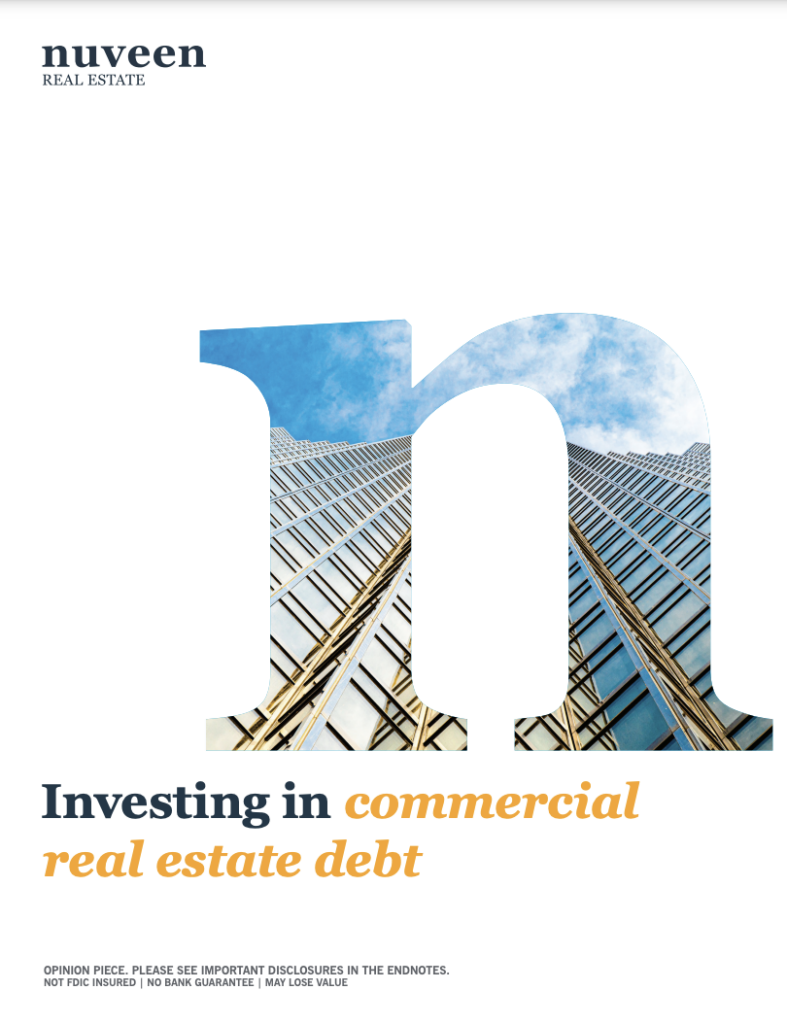In an environment where disruption in capital markets is shaking up the status quo for many lenders, Nuveen Real Estate is continuing to dispense a steady flow of debt financing at attractive rates for investors.
Capital markets have changed dramatically in the past year. Although there were signs of early-stage disruptions with spreads widening in CMBS and CLO lending in the second quarter of 2022, bank markets were still open and functioning with capital being deployed rather freely. However, liquidity dried up quickly moving into the second half of last year, starting with the larger banks pulling back towards the end of the third quarter last year. “It became pretty clear that the capital markets were not functioning with adequate liquidity, and that’s really where we sit today,” says Jack Gay, global head of commercial real estate debt at Nuveen Real Estate.
Although capital markets are still functioning, they are operating with a lot less capital available, and ongoing negative headlines in the banking sector related to bank failures continue to have an impact. “We see fits and starts and some green shoots of liquidity coming back into the market here and there, but it’s choppy in the capital markets at best right now,” says Gay.
The positive side of the more constrained lending market is that it’s creating opportunities for non-bank lenders to deploy capital at very attractive rates. In addition to the rise in base rates on debt priced off SOFT, credit spreads also have widened.
“The returns that we’re seeing from the loans we are providing, or capital being deployed now are as good as we’ve seen in many years. And we’re also underwriting off what I would say are more conservative terms,”
Ultimately, that translates to higher quality loans. Nuveen Real Estate is making loans at lower loan-to-values, with more structure around the loans and a reset basis in terms of valuations.
Lending into strong sectors
Access to debt financing remains a very different story based on the individual property type. Office is the sector that is getting most of the headlines and has very little, and in some cases, no liquidity. Investors holding maturing debt will have to navigate through maturities very carefully, at least until liquidity returns, notes Gay. On the other end of the spectrum, multifamily still has good debt liquidity in part due to agencies still actively lending into that sector. In addition, both multifamily and industrial are more favored sectors, with good liquidity from lenders. “Those sectors are still seeing pricing pressures on their way up, and investors are still getting paid very handsomely for lending into those sectors,” adds Gay.
The demand fundamentals behind industrial, and multifamily are still quite healthy across many markets, and top line revenue is still growing due to favorable characteristics and good supply and demand balances. The industrial sector is still seeing growth driven by online shopping and demand for local warehouses and distribution centers. “The top line in those sectors will probably outpace the pressures that we’re seeing from underlying cap rates and underlying interest rates pushing up the cap rates,” notes Gay.
Industrial remains favorable due to the continued supply-demand imbalance that is resulting in strong rent growth. “While rents aren’t growing at the same pace as they were 9 to 12 months ago, there’s still tremendous growth in industrial,” says Gay. Multifamily also has strong fundamentals. Although there have been pockets of overbuilding in multifamily, the U.S. is still battling a housing shortage. “It’s a little bit more market by market in terms of looking geographically where there’s been excessive building and softening in terms of rent growth and vacancy rates,” notes Gay. However, fundamentals remain strong across multifamily, and there are opportunities in select markets, he adds.
Office is a more capital-intensive business than other sectors in terms of capital that needs to be invested into the assets below the line, such as tenant improvements and leasing commissions, which consume a much higher percentage of NOI in the office sector as compared to industrial and multifamily. It’s more difficult to finance those kinds of deals than in an environment where interest rates are not hovering near zero. There is also the “return to work” discussion. Will companies invoke strict office-only policies? Will some stay with hybrid models? Will others go to full-time remote? “Demand for office space remains an interesting topic of discussion, and it’s clearly more difficult to finance those deals today compared to an environment where interest rates are hovering near zero and employees were in the office full time,” says Gay.
Niche sectors continue to expand
Lenders are continuing to find attractive opportunities to provide capital outside of the traditional core four property types. Nuveen Real Estate likes the opportunities that exist in alternative sectors that are exhibiting strong supply and demand fundamentals and are likely to be more resilient through an economic downturn, such as single-family rentals, storage, life sciences and medical office. “We are being a bit more analytical and asking more questions in these sectors, but in the long run, the demographics of the country prove out for those sectors as well,” he says.
Another lending product that is filling the gap created by disruption in capital markets is C-PACE. Commercial Property Assessed Clean Energy or C-PACE is a financing mechanism that provides commercial property owners access to low-cost, long-term, fixed-rate capital for energy efficiency, water conservation, and renewable energy improvements. Financing is paid back over a 20+ year term through a special property assessment. C-PACE is a U.S. phenomenon where state laws enable lenders to finance energy improvements on CRE or new construction projects and have the loans serviced through local tax collectors, allowing for 30-year fixed-rate repayment schedules, notes Gay.
Nuveen Real Estate has deployed more than $1 billion in C-PACE financing to borrowers over the past four years through its affiliate, Nuveen Green Capital. “There is so much opportunity in the market. We’re just scratching the surface,” says Alexandra Cooley, co-founder and chief investment officer of Nuveen Green Capital.
Credit strategies have been increasingly popular in the recent high inflationary environment with debt investments providing a good inflation hedge, and there are ample opportunities ahead to deploy capital. Effectively, non-bank lenders are getting paid a premium for the illiquidity in the market. “Eventually, markets will find a balance and the illiquidity will go away,” notes Gay. “But if you can take advantage by lending into the market when others are not, making this a very attractive time to lend.”
The Nuveen Real Estate Debt is designed to provide investors access to secure, income-focused returns. Our strategies may suit cautious investors seeking attractive levels of income with a measure of downside protection against short-term market cycles. Connect with our industry experts to learn more.




